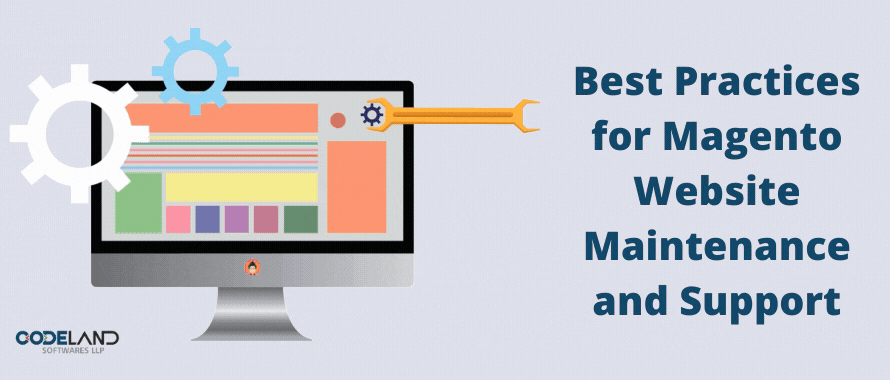Best Practices for Magento Website Maintenance and Support (The Ultimate Guide)
codeland
October 28, 2020

Magento is one of the most-liked and top-rated content management systems available out there. It enables us to create an online store that suits your style, selecting, and picking elements you need. However, it’s not free of drawbacks. When consumers face issues on your site, it impacts their experience. Your reputation might get affected and have financial losses. Thus, you need to follow best practices for Magento website maintenance and support and implement essential security measures to ensure your business operations are running smoothly.
Top 9 Practices For Magento Website Maintenance and Support

1. Upgrade Your Magento Store
The first and foremost step for Magento website maintenance and support is to upgrade your Magento site to the latest version. Magento often releases updates to address security issues. By upgrading the site to the updated version, you can protect your Magento site from hackers or snoopers. Recent researches revealed that United States consumers lost 19.4 billion dollars and several hours dealing with the impact of Cyber Thefts. Upgrading to the latest version protects your site from snoopers and hackers. Benefits of upgrading Magento website to the latest version like:- System compatibility and ease of upgrade
- Instant process and mail marketing automation
- Improved checkout process
- Advance reporting and instant purchase
2. Opt For A Dependable Hosting Service Provider
The second yet significant step for Magento website maintenance and support is to hire a trustworthy web hosting service. It ensures a lag-free running website. However, you need to ensure that team complies with industry standards. Hire professionals based on certain factors. It includes your Magento store’s size, the amount of traffic you want, and your Magento version’s system requirements.“Codeland Infosoft Technologies” offers practical and dependable hosting services. Feel free to contact us for consultation.3. Server Environment
Make use of an anti-virus software scanner frequently and keep anti-virus software up-to-date. It’s better not to install and download software or files on suspicious links. You need to make sure that your server system is secure and protected. You need to check for unnecessary applications running on the server. We will ask you not to go for FTP or employ easy-to-decode passwords. Instead, implement encryption protocols like SHTP, HTTPS, or SSH to access your remote files. You need to change passwords from time-to-time and make use of strong passwords. Please keep track of Magento’s software components’ issues include database, Apache, PHO, OS, and My SQL.4. Regular Optimization of Server
Often security logs and system logs and files get generated. You need to remove the redundant files. Frequent data optimization is essential, but you need to carefully implement the optimization and leverage the optimization of certified professionals.5. Apps Used On The Server-Side
It will help if you don’t use other software on the same server on Magento CMS. There can be loopholes or vulnerabilities in sites that lead to confidential information theft in the Magento system. Keep all software updated and conduct Magento security patches whenever needed. Install the latest version of Magento. It’s wise to go for the latest Magento version as it has the recent security measures and protocols. You need to install the current version from trusted sources. If you’re not able to upgrade, then download all Magento patches. You need to use unique URL links and refrain from using the “backend” or “administrator” links. It might result in exposure to codes that can break into the official site. Moreover, block access to systems as it might get product data beaks. Use eight characters or alphanumeric password and employ Magento’s configuration settings. It’s essential to develop a recovery plan for e-commerce sites. Magento Website Maintenance and Support is very important in this time.6. 24/7 Monitoring of Server
Robust tools like Ruxit and New Relic enables you to track the server 24/7. In case the Magento site needs an upgrade or a security threat gets imposed, these tools will notify you. Employing these tools prevents serious issues. It provides you a viable long-term solution for Magento website maintenance and support.7. Implement Advanced Security Measures
Magento implements the JIRA system for fixing the loopholes or bugs. It releases the patches to provide port tickets. The security patches (aka SUPEE patches) includes scripts consisting of updates of all security issues.8. Install Magento Patches or SUPEE Patches
Hosting environments and server patches vary from one system to the other. There are three ways to install Magento patches, and you can choose one as per convenience.- Implement SSH encryption protocols
- Implement any other encryption protocols (not SSH)
- Run a script
9. Upgrade And Test Staging (Duplicate) Sites
The staging site refers to the replication of an original website. Developing staging sites makes it easy for you to test the features and functionalities. Then you can decide on the one that works best or meets your requirements. However, to get expected outcomes, you need to upgrade the sites as you do with the original one. It might appear to be laborious, but it’s essential to achieve that meets your requirements. Recovery plan as suggested by MagentoYou need to consult with your IT team, system manager, or hosting service provider to determine the cause of the attack. Types of Magento Attacks:- Server Attacks: It results in installed backdoors or data compromise.
- Site defacing: It gets consumer accounts compromised.
- Sniffing: Hackers can install card capture software or malware like Trojans or virus-infected software.
Final Words:
Magento offers advanced features and solutions for website creation. It is advisable to take measures to maintain your eCommerce store with our Magento website maintenance and support. It will help you to avoid complications in the future. Following the best practices for Magento website maintenance and support, it will give you improved experiences to your end-users and help you deal with complex integrations related to security.If you are looking for well-versed, skilled, and certified Magento 2 developers to keep your store running safe and sound, get in touch with us today to leverage top-of-the-line Magento website maintenance and support services.Recent Posts
- eCommerce Trends for 2020
- 10 Reasons Why WordPress is The Best CMS
- Artificial Intelligence in Magento 2: Creating New Possibilities for Magento eCommerce Stores!
- Magento 2 Product Types: Here’s Everything You Need to Know About! (Explained with Examples)
- A Comprehensive Guideline: How to Hire Magento Developer in 2021
- 12th Floor, 1215, Ganesh Glory Jagatpur Road, Sarkhej - Gandhinagar Hwy, Ahmedabad, Gujarat. -382481
- info@codelandinfosoft.com
- +91-(971) 411-1577
Copyright © 2021 CodeLand Softwares LLP – All Rights Reserved



